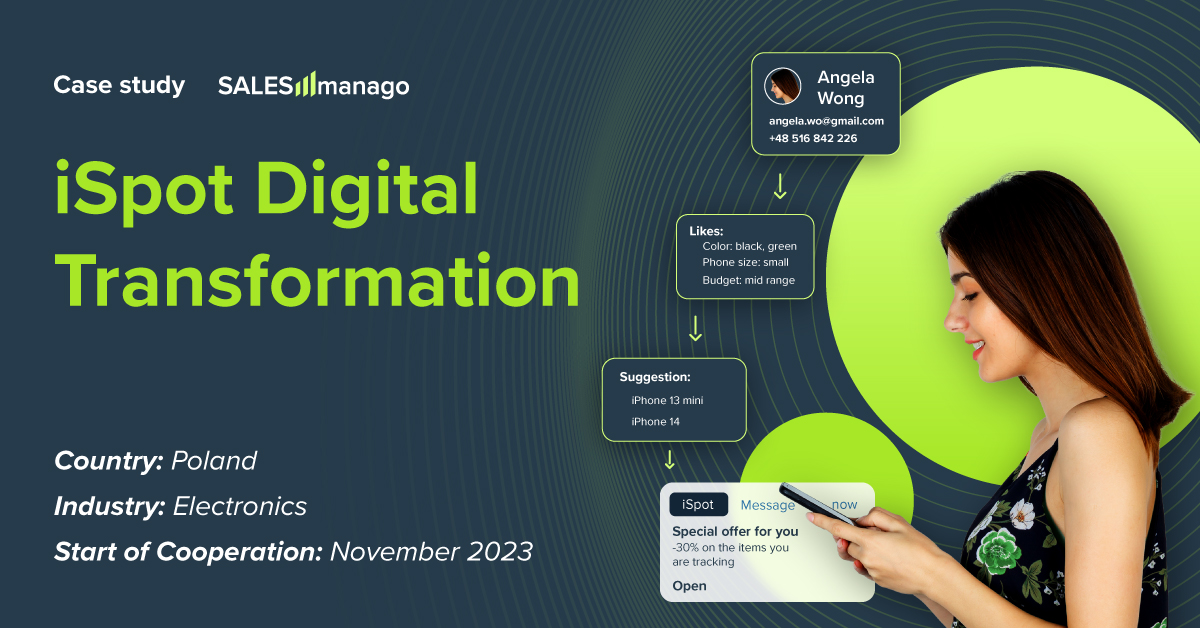
There are modern tools today that help companies interact better with customers and build stronger relationships based on trust and loyalty. Customer engagement software (CES) is a smart investment for both small businesses and larger companies.
The importance of CES lies in its ability to centralize communication, personalize experiences and maximize business results. In this article you'll learn what customer engagement software is, how it works, its benefits and future trends.
What customer engagement is and how to measure it
In the past, offering a quality product or service was enough to attract customers. Today, however, data and analysis show that engagement plays a significant role in the buying decision. Statistics show that 88% of customers value a company's experiences as much as its products and services.
Every customer interaction provides an opportunity to build customer loyalty, but at the same time, you collect valuable information about their preferences and needs. This information is essential for making informed decisions, whether it's marketing, sales, or improving the overall brand experience.
Active customer engagement therefore has a significant impact on business success. You can measure the level of engagement with a handful of tools:
Customer Satisfaction Score (CSAT);
Net Promoter Score (NPS);
Conversion Rate;
Pages Per Session;
Average Session Duration;
Customer Retention Rate.
What is customer engagement software
Customer engagement software unifies multiple digital channels, such as email, SMS, WhatsApp, and live chat, to ensure constant and personalized customer communication. Its main goal is to simplify the management of interactions and deliver consistent experiences, improving the relationship between business and customers. This ensures that, regardless of the platform used, a constant and seamless experience is provided, which helps provide quick and relevant responses to each customer's needs.
Types of customer engagement software can include: social media management platforms, CRM systems, customer feedback collection solutions, email marketing software, chatbots, analytics and reporting applications, and more.
NOTE. While some may confuse CES with CRM, it should be noted that they serve different purposes. CRMs focus on managing customer data, tracking sales and organizing relationships. Customer engagement software, on the other hand, facilitates real-time interactions and communication automation and is ideal for direct interactions with customers.
How customer engagement software works
CES integrates seamlessly with tools such as CRMs, email platforms, and social media management software. By merging these tools, companies improve efficiency and deliver a personalized and consistent customer experience.
In addition to conversation management, the software provides real-time analytics, monitoring metrics such as response times and customer satisfaction. This data allows you to adjust strategies, for example, automating responses or prioritizing customers' preferred channels.
To effectively implement customer engagement software, start by setting clear goals. Decide whether you want to improve response times, customer satisfaction or retention. Choose the right functionality, such as chatbots or autoresponders, to automate repetitive tasks and allow your team to focus on more complex issues.
Benefits of using customer engagement software
There are some important benefits for companies using CES:
Enhanced customer satisfaction and loyalty
By personalizing interactions and prompt responses, customers feel appreciated, increasing their loyalty.
Improved communication and personalization
These solutions enable companies to automate and integrate customer data and interaction activities, facilitating more effective and personalized communication.
Streamlined customer service and support
These modern tools help streamline the customer engagement process, enabling support teams to deliver fast and efficient solutions.
Increased sales and revenue growth
By automating marketing campaigns and personalizing offers, companies can reach a wider audience and improve conversion rates, generating higher revenue.
Key Features to Look for in customer engagement software
Effective customer engagement software offers key functionality including:
Multi-channel communication support
Enables interaction with customers across multiple platforms, such as email, social networks or live chat, centralizing all conversations.
Real-time analytics and reporting
Provides insight into performance and trends to facilitate rapid strategy adjustments.
AI-driven recommendations and automation
Simplify repetitive tasks and personalize customer experiences using artificial intelligence.
Integration with existing tools and platforms
Ensure connectivity with CRM, marketing software or other essential systems for increased efficiency.
Top customer engagement software tools in 2025
Here's a look at the most popular customer engagement tools used in 2024 that will be in high demand in 2025:
1. HubSpot
HubSpot is a comprehensive platform for marketing, sales and support, integrating CRM and automation. The platform helps companies personalize interactions and strengthen customer relationships.
2. Salesforce
Salesforce is cloud-based CRM software that unifies customer data and helps teams collaborate effectively. With built-in artificial intelligence, it improves productivity and delivers personalized experiences, facilitating quality service.
3. Intercom
Intercom focuses on customer conversations through channels like live chat, email and automated messaging. The platform uses automation and advanced segmentation to deliver fast and personalized responses, significantly improving customer satisfaction and loyalty. The solution is suitable for various business types, from small businesses and start-ups to mid-sized companies.
4. Zendesk
Zendesk is a leading solution for customer support management. With features such as omnichannel ticketing, knowledge bases, and automation, it helps businesses efficiently manage customer requests, reducing response times and increasing overall satisfaction.
5. SALESmanago
SALESmanago offers advanced marketing solutions based on artificial intelligence and personalization. Its multi-channel integration and predictive capabilities enable companies to create relevant marketing campaigns, increasing conversions and improving customer experience.
Choosing the right customer engagement software
To make an inspired choice for your company, consider the following factors:
Business size and industry: Choose software tailored to the specific needs of your industry and team size. For example, for retail, finance or healthcare, you might choose Salesforce. Conversely, Zendesk is great for eCommerce, as is SALESmanago.
Budget and scalability: Opt for a solution that fits within your budget and can grow with your business. An example is HubSpot, which offers scalable plans as your business grows.
Business goals and needs: Find a tool that directly supports your goals, whether you're aiming for higher sales or better customer satisfaction. For focus on automating customer interactions, omnichannel support, and using artificial intelligence, you can rely on Intercom.
Short checklist for evaluating CES options:
Is it compatible with other platforms?
Does it include useful analytics and reports?
Does it offer automation and personalization features?
Challenges and Limitations
There are several challenges you may face in implementing CES:
Integration with other existing systems, such as CRM or automation systems;
Some CES may have limited functionality;
Teams may have difficulty adopting and using them correctly;
Costs: purchasing and maintaining a CES can involve considerable expense, making it a challenge for companies on a tight budget.
To overcome CES challenges, solutions may include the following:
Training the team for efficient use;
Integration with other systems (CRM, e-mail, etc.);
Automation of repetitive processes;
Constant feedback to improve the experience;
Scalability of the solution to business needs;
Customization of functionalities for the specific business.
Future trends in customer engagement software
In the future, there are some CES directions and trends you need to know about:
The rise of AI and machine learning
Will enable automated interactions, providing faster and more personalized solutions for customers.
Integration with IoT and new technologies
Will make it easier to connect devices and data for a unified and efficient experience.
Focus on hyper-personalization
Will enable companies to tailor content and services to each customer's specific needs.
Increasing importance of privacy and compliance
Will focus on protecting user data and complying with strict regulations.
Conclusion
When customers feel connected and valued, their trust and loyalty increase significantly. By using customer engagement tools, you can better understand their needs to deliver personalized experiences. What's more, happy customers become the best advocates for your business, helping to build a loyal community that consistently supports your brand. Strong engagement brings not only growth, but also a lasting and positive relationship with every customer.
So, by investing in such a tool, you can transform the way you interact with your customers. Explore the available options and choose the solution that best suits your needs!
Latest posts

iSpot's Digital Transformation: How Poland's Apple Premium Partner Achieved 70x ROI with SALESmanago
When Poland's leading Apple Premium Partner sought to transform their customer experience from transactional to relational, they turned to SALESmanago. The results? A staggering 70x ROI, email engagement rates 1,334% higher than industry standards, and a seamless omnichannel experience that perfectly complements their premium product offerings. Here'...

#Growth Hack Series: Master Acquisition with Web Engagement Studio
Your website is leaking opportunities. Every. Single. Day.You're driving traffic. You're investing in campaigns. But most of your visitors exit without leaving anything behind—no d...

From B2B to BwB: Why the Future Belongs to Brands That Build With, Not For, Their Customers
There’s a growing shift happening in how we sell, how we partner, and ultimately, how we grow. And it starts with a simple truth hiding in plain sight: People don’t want to be sold to—they want to build something with you.The classic B2B dynamic—where vendors pitch, buyers listen, and decisions are made in isolation—is breaking down. What’s emerging in its pla...